Weekly round-up: 02 - 08 Sep 2015
Was this autumn? The weather gods do like their little jokes, and this week’s rib-tickler came right out of the Arctic – with a big slab of low pressure anchored unhelpfully over the North Sea the week began with a frisky northerly wind chasing down the east side of the country like, well, a really very unhelpful thing indeed.
Easterlies, south-easteries, and north-easterlies at a pinch. That’s what this time of year should be all about. Plenty of time yet, mind – and as the week progressed the low pressure was pushed away by a generous dollop of high pressure that brought sunshine to much of the UK. And while it’s nice to go birding in a t-shirt in the late summer, what’s even nicer is when some high pressure moves out towards Scandinavia and the wind starts a-swooping towards us from beneath it. And that’s just what looks like happening shortly...
Expect much drift-related joy down the east coast in the coming days.
In what was a generally rather quiet week of news, at least one of the previous week’s duo of juvenile Pallid Harriers continued to lob around Shetland’s South Mainland. As anyone who was fortunate enough to be birding in the same area in September 2011 could attest, actually keeping tracks of these effortlessly mobile birds can be surprisingly tricky – for what looks on paper like a relatively small area is in reality a crumpled and corrugated bit of terrain with myriad hills and folds in the landscape for a bird (or birds) to lose themselves in.
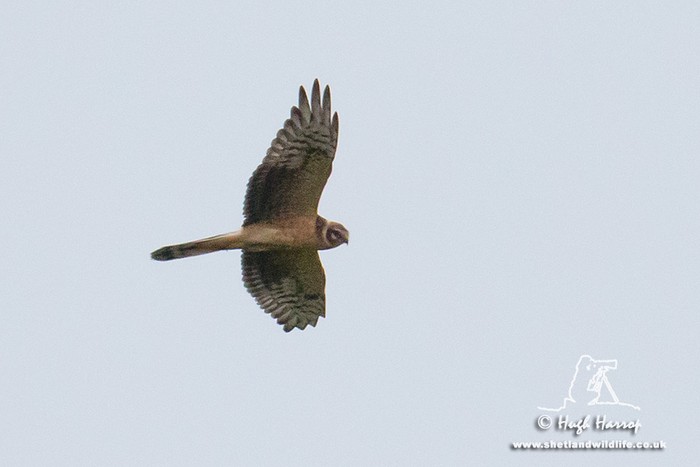
And so it proved this week as one (or both) of last week’s individuals floated in and out of local birders’ consciousness – being seen at Levenwick on 3rd, and back at Hillwell again on 6th-8th. Birds seemed to stick around a while during the 2011 influx, and it wouldn’t be entirely unreasonable to hope that history may repeat itself this year – and of course as the coming weeks unfold we’d like to think more of these beautiful raptors may make landfall in the islands.
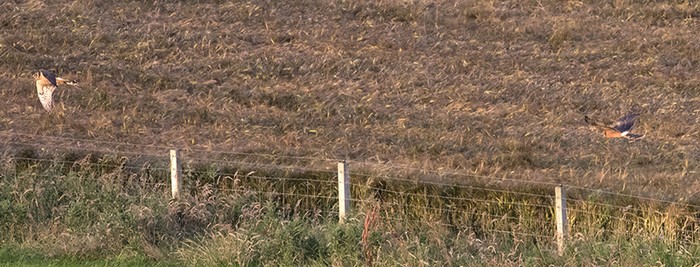
And, for that matter, elsewhere down the east coast. Pallid Harrier may have become slightly more commonplace in recent years, but it should remain a stellar bird for anyone working on their self-found list.
While we have no new individuals to report, Black Storks remained a feature of the early autumn news this week with two birds continuing to provide value all week long. The French-ringed juvenile was still finding East Yorkshire’s Stone Creek a hard habit to kick, while in East Sussex the juvenile remained at Cooden, being seen there on a daily basis.
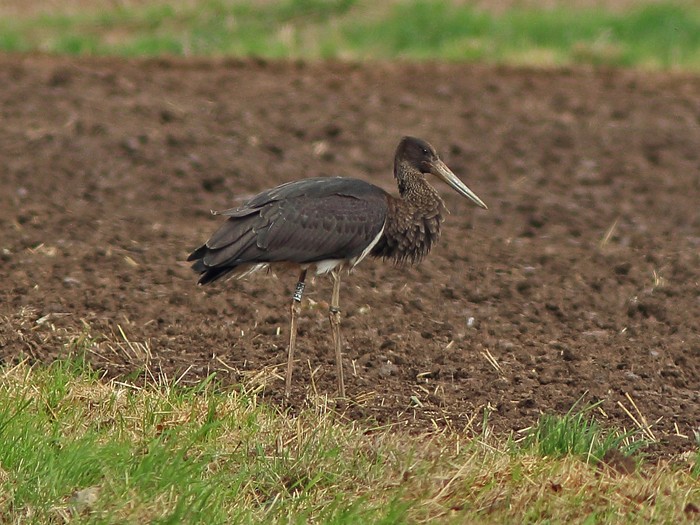
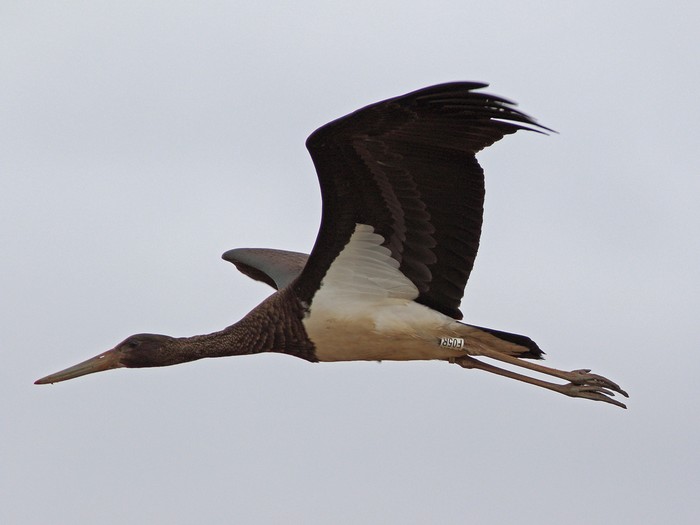
Just when it looked like the week was closing fairly quietly, it only fell to a seabird to shake things up a little and reward the north-easterly seawatching faithful’s patience and long hours manning the scopes.
At the stroke of tea-time on 8th sharp eyes on Flamborough Head (East Yorkshire) picked up a Fea’s / Zino’s Petrel at long range moving north. There was a certain inevitability (though no doubt plenty of trepidation involved) about what was presumably the same bird being picked up some 80 minutes later off Scarborough, still heading north – a superb re-find, but a bit of a sickener no doubt for Filey...
Since the first accepted records off Flamborough in 1991 there have been a grand total of 13 accepted records from the county at large; and most of these have also been from Flamborough Head. It’s one heck of a vantage point, and it has some stellar records both accepted and fallen by the wayside to its name.
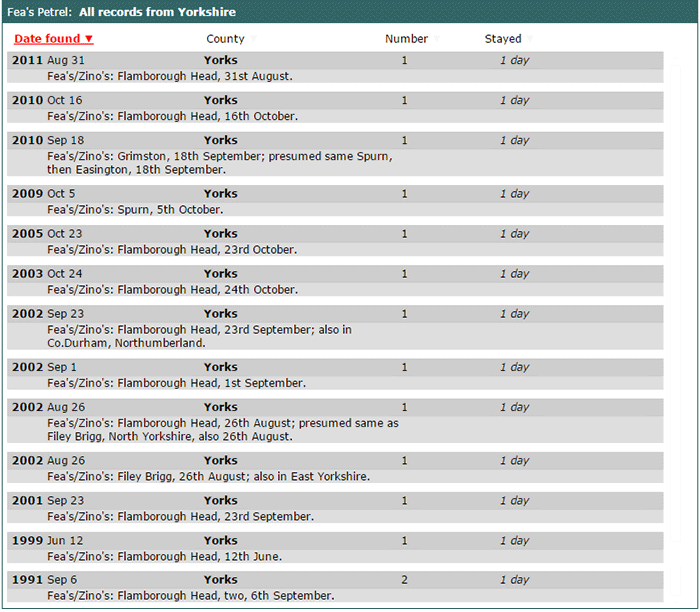
Last week was always going to be a hard act to follow – frankly, any week following one with a multi-observed Red-billed Tropicbird is going to feel like the birding equivalent of entering the doldrums, short of something even more stupendous like a frigatebird happening.
Alas, one didn’t. And despite an intriguing report from non-birders of a Red-billed Tropicbird perched on the rocks off Mousehole (Cornwall) on 7th, subsequent searches of the area failed to turn it up again. The romantic in me just wants to think it’s still mooching around the Cornish sea area, and is eventually going to give itself up. The realist in me knows that this is a seabird, and seabirds don’t do easy.
Meanwhile numbers of interesting seabirds continued to ebb and flow around the country. Numbers of Balearic Shearwaters fell through the floor from last week’s three-figure tallies with some 90 individuals noted from eight English and three Welsh counties. Most of these involved one or two birds, scant reward for their observers’ dedication and long hours staring out to sea – the peak count for the week came from Strumble Head (Pembrokeshire) on 3rd, with a total of eight birds logged past there during the day.
Large shearwaters too dwindled away to almost nothing. Starting with Cory’s Shearwaters , there were a mere handful of birds to report, all off the east coast. A probable was noted off Kessingland (Suffolk) on 3rd; on 5th, one was seen in Norfolk from Blakeney Point with a further possible sighting from Holme Dunes NWT, while singles were seen further north that day in East Yorkshire from Flamborough Head and Spurn.
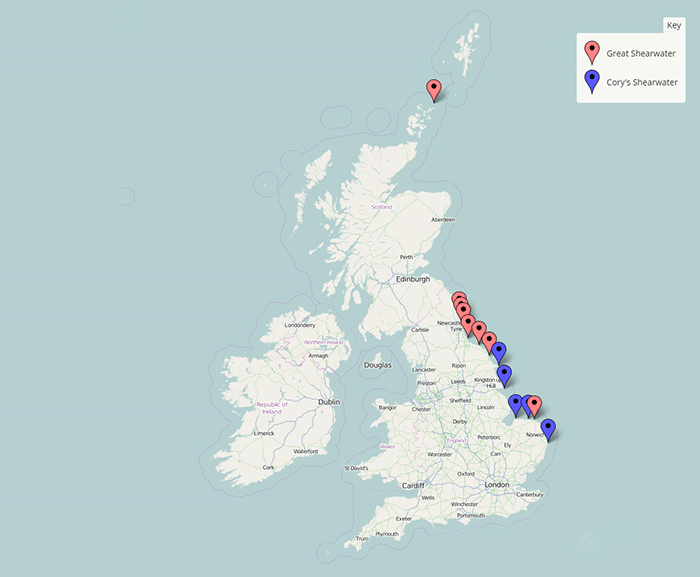
There were equally slim pickings of Great Shearwaters - North Ronaldsay (Orkney) scored a good northerly record of one on 4th, whilst just like the Cory’s the 5th was a (relatively) busy day for the species: singles were noted from Sheringham (Norfolk), Cowbar and Hartlepool Headland (Cleveland), Whitburn Coastal Park (Co.Durham), and Newbiggin-by-the-Sea and St Mary’s Island (Northumberland). On 6th a further record came from East Yorkshire’s Kilnsea.
Long-tailed Skuas remained a distinct possibility for anyone of a seawatching frame of mind this week – around 75 were logged from ten English, two Welsh and one Scottish counties. Winner’s laurels go to Sheringham (Norfolk) where a round dozen were noted on 4th. Elsewhere it was the usual story for the most part with singletons or duos the state of play – while nothing approached Sheringham’s double figures, Blakeney Point managed five birds on 5th with Flamborough Head (East Yorkshire) tallying four on 6th. A notable record came from Chew Valley Water (Somerset) on 7th, where a juvenile was noted.
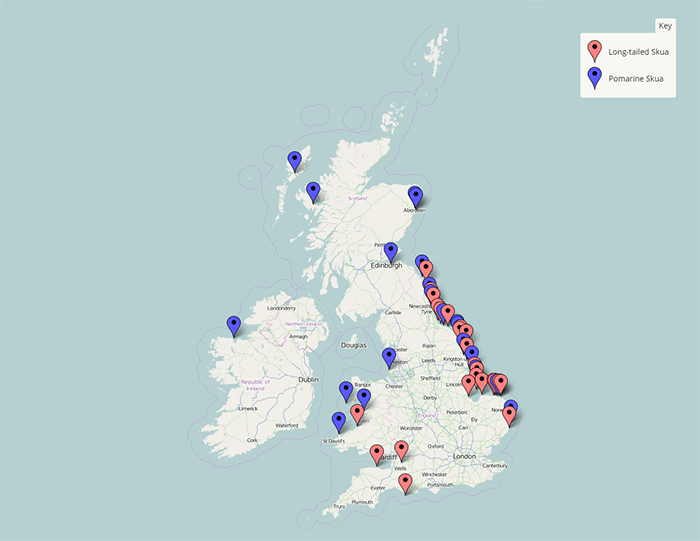
A shade fewer Pomarine Skuas were seen, with some 70 birds reported from around the country from ten English, two Welsh and three Scottish counties. Again, most of these records involved the odd one or two birds scything past a headland, with easily the most notable tally coming from Co.Durham’s Whitburn Country Park where 18 birds were noted on 5th.
The same site came close to landing the metaphorical biggie the previous day, with an unconfirmed report of a Barolo Shearwater seen passing by early in the morning. So near, and yet so far.
Our weekly strut through the various long-legged beasties must start with the aftermath of last week’s massive flock of Cattle Egrets. Belated news emerged from last week that 25 were seen heading past Brightstone (Isle of Wight) on 30th August. This week the flock had dissolved Alka-seltzer-like into the English countryside, leaving just a faint hangover over egrets to remind us of the wild party that had preceded matters.
The week kicked off with two birds in Dorset at Coward’s Marsh on 2nd-3rd, with five seen over Longham Lakes in the county on 2nd. In nearby Hampshire one passed over Blashford Lakes on 2nd, with one at Titchfield Haven NNR from 2nd-5th and one briefly at Farlington Marshes HWT on 3rd. Further east still, one was at Rodmell (east Sussex) on 2nd.
The Dungeness area remained attractive for one bird from 3rd-6th while back in Dorset the week closed with a pair at Abbotsbury on 7th.

Heading north, the Night Heron was reported once again at Swillington Ings (West Yorkshire) on 3rd.
An unconfirmed report emerged on 6th of a Purple Heron in Lincolnshire at Kirton Marsh.
It’s been ever so quiet on the Glossy Ibis front lately, so it felt for this reviewer at least like the welcome return of an old friend to see the news flash up of one at Tramore (Co.Wexford) on 5th.
And so to Spoonbills where Poole Harbour (Dorset) continued to act like a magnet for the species this week. Numbers on Brownsea Island’s lagoon peaked at 21 on 8th, while 24 birds were noted on 5th from Arne RSPB. A mere 13 birds were seen at Wareham on 4th.
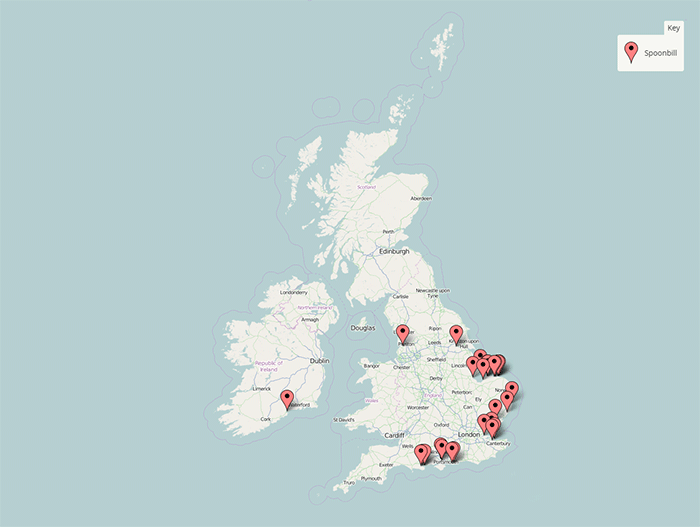
Moving east around the English coast there were just scraps from the table for Hampshire and West Sussex: single birds were in Hampshire over Warsash on 6th and at Titchfield Haven on 7th, and one was at Medmerry RSPB (West Sussex) on 4th. Somewhat more respectable numbers were kicking around the north Kent coast, with Cliffe Pools RSPB accounting for four on 2nd , five on 4th and down to two on 8th; and Conyer Creek and Harty Marshes logging six birds on 5th.
Up into Essex where two birds remained at Fingringhoe Wick EWT on 2nd, with two noted over Gunners Park that day, and a modest increase at Fingringhoe Wick by 8th when there were three birds there. In Suffolk one was at Dingle Marshes SWT on 3rd. And so to Norfolk, where it was business as usual with the mighty Titchwell RSPB once again dominating proceedings – the week started with a respectable 16 there on 2nd, and peaked with 19 there on 4th. Elsewhere in the county one was at Snettisham RSPB on 2nd; two were at Salthouse on 3rd with one still there on 8th; while on 6th three were at Stiffkey Fen with five seen from Warham Greens (three still at the latter site on 7th). On 8th 11 birds were on the marshes at Burnham Norton.
All of which just leaves Lincolnshire to wrap up the English Spoonbill sightings this week: they remained a constant on Gibraltar Point NNR with numbers fluctuating daily but peaking with six individuals on 3rd-5th. One was still at Hesketh Out Marsh RSPB on 2nd, with two there on 4th-8th. Two remained at Frampton Marsh RSPB on 4th-8th, and one was at Alkborough Flats on 6th.
Ireland brought one Spoonbill to the party - one was again at The Cunnigar in Co.Waterford on 5th.
Away from the reliable Norfolk Broads the sole report of Common Crane this week was the settled individual still at Blithfield Reservoir (Staffordshire) until 8th.
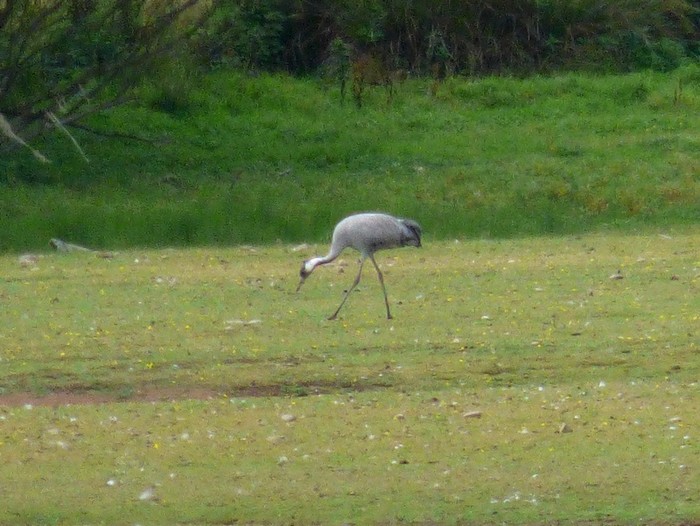
We’ve just the two migrant Corncrakes for you, at Wiveton (Norfolk) on 2nd and Fair Isle (Shetland) on 8th.
Things were definitely picking up on the duck-front this week, with considerably more variety and numbers alike than we’ve enjoyed of late. We’ll kick things off with last week’s two (and practically only) stars...
Somerset’s Chew Valley Lake began the week with both the drake Lesser Scaup and the female Ferruginous Duck both still present on 2nd. The former was still there until 6th at least, with the latter remaining until 8th.
Three American Wigeons were found during the week, with one apiece for England, Scotland and Ireland. An eclipse drake was in Northumberland at Grindon Lough on 2nd-4th; another eclipse drake was found at Caerlaverock (Dumfries & Galloway) on 6th-7th; while in Ireland one was at Tacumshin (Co.Wexford) on 6th-8th.
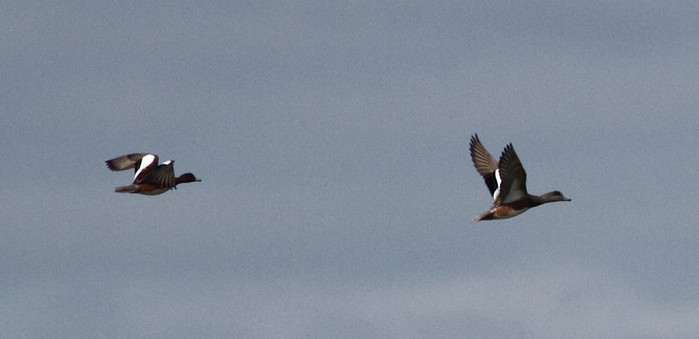
A female or immature Blue-winged Teal was in Co.Derry at Lough Beg on 5th.
The drake Surf Scoter remained in Lunan Bay (Angus) until 3rd. Two further birds were noted elsewhere in Scotland – a first-summer drake was seen off the regular stretch of Aberdeenshire coastline at Murcar on 4th-6th, while a drake was seen in the Sound of Taransay (Western Isles) on 6th.
There was a smattering of shorebird variety on offer this week, albeit without an outstanding drop-everything-and-fire-up-the-Quattro individual to report.
Top-billing goes to a bird that scraped in at the close of the week, Lincolnshire’s tenth Wilson’s Phalarope, seen briefly at Frampton Marsh RSPB in the late morning of 8th. The tenth record for the county and the first one in five years – after a golden spell in the mid 1980s when the species racked up five showings between 1984 and 1987 it’s become rather more sporadic in Lincolnshire. The species has a habit of sticking around for a few days, so we’ll see if this individual features in next week’s Round-Up... The same site scored a juvenile Red-necked Phalarope the very same day.
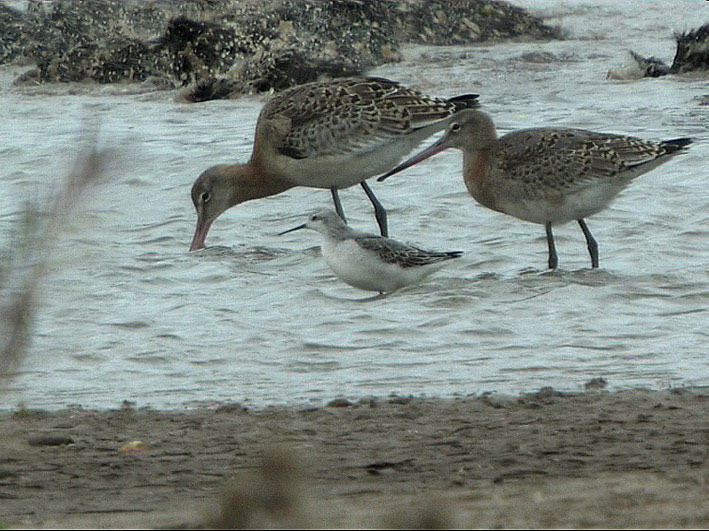
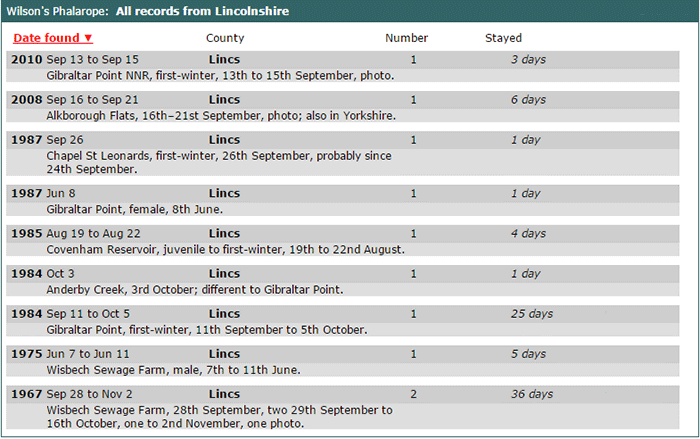
Further American loveliness was meanwhile happening on 8th up in Shetland, where a Long-billed Dowitcher was to be found near West Sandwick on Yell. That’s just a few miles as the lost dowitcher flies from my house. I shall have the speakers hanging out the windows this evening blasting dowitcher calls across the water...
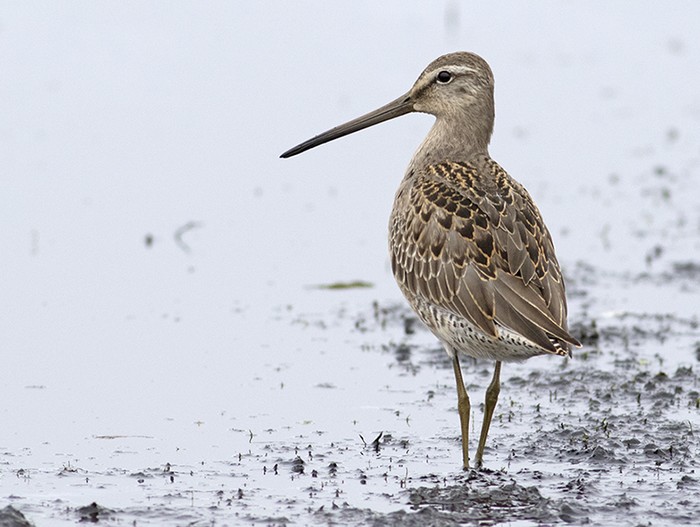
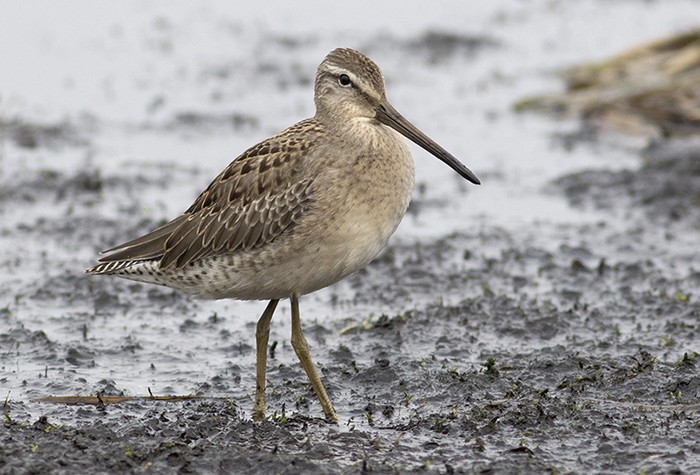
It’s that time of year when paying close attention to the local Golden Plover flock can pay dividends. (Note to self – do this, immediately). And so it was in Shetland on 5th when a cracking adult American Golden Plover was found at Sandwick. More of these to come in the coming weeks...
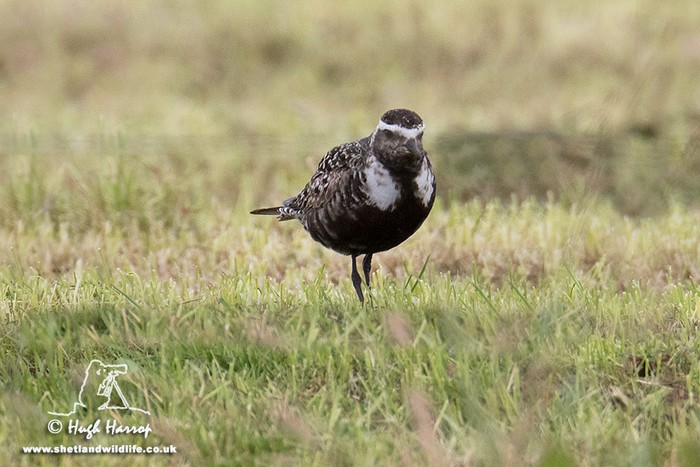
Meanwhile in Ireland the adult Pacific Golden Plover, last seen on the day it was initially found on 23rd August, was once again in the same field it had been in previously at Myroe Levels (Co.Derry) on 6th.
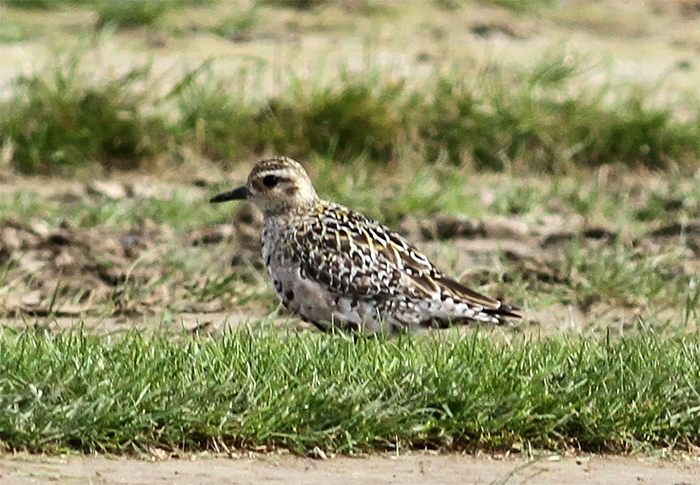
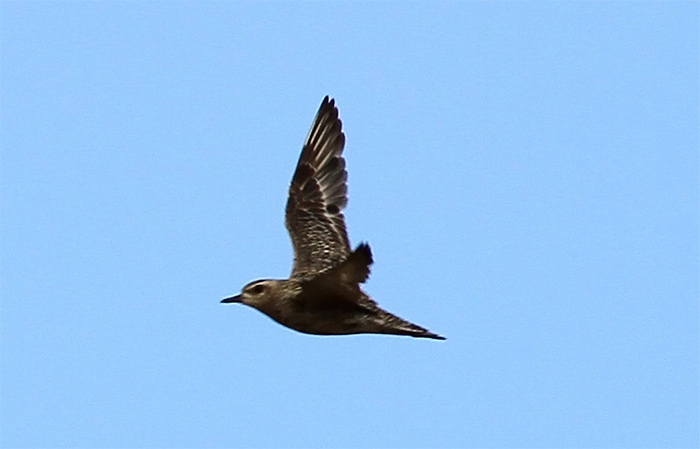
A report of a juvenile Lesser Yellowlegs on the Ribble Estuary with Redshanks at Lytham St.Anne’s (Lincolnshire) on 3rd remained, sadly, unconfirmed.
Far more tangible were this week’s showing of Pectoral Sandpipers, nudging as they did their way into double figures – 11 were recorded across the region. All involved single birds with the exception of Orkney’s South Ronaldsay where two birds were together on 6th. Elsewhere, singletons were at Blyth (Northumberland) and Ramore Head (Co.Antrim) on 2nd; on 3rd-5th at Aldcliffe Marshes (Lancashire); at Ardvule Point on South Uist (Western Isles) on 4th; on 6th at Abberton Reservoir (Essex) and on 6th-7th on Fair Isle (Shetland); on 7th at Medmerry RSPB (West Sussex) and Tresco (Scilly); and the week closed with a final bird in West Sussex at Siddlesham Ferry.
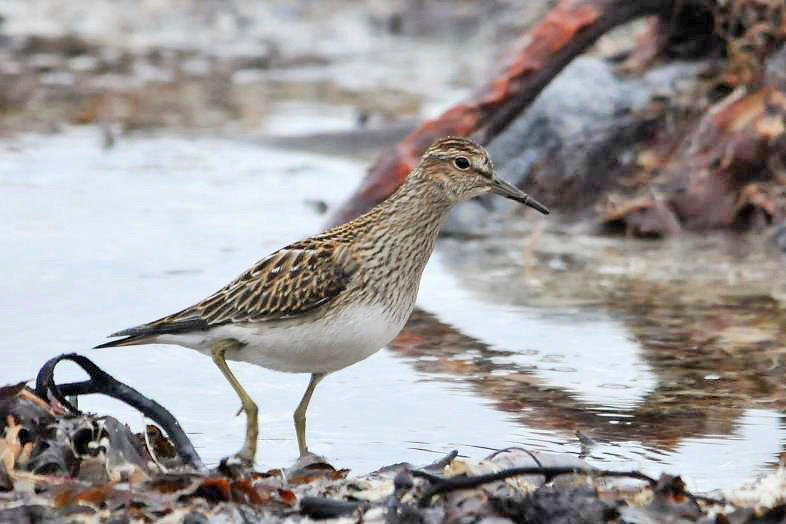
Four reports of Temminck’s Stints emerged this week – two on 7th, one at Conwy RSPB (Conwy) and another on Cornwall’s Hayle Estuary – and two on 8th at Frampton Marsh RSPB (Lincolnshire) and on Sherpa Marsh at Braunton (Devon) respectively.
Less of a trip and more of a stumble where Dotterels were concerned – one was reported from South Ford on South Uist (Western Isles) on 3rd; another was on top of Foel Fras (Gwynedd) on 7th; while on 8th one flew over Polgigga (Cornwall) and one was in Devon at Thurlestone.
All of which brings us to a couple more phalaropes with which to wrap the week’s shorebird offerings up – a Grey Phalarope off Strumble Head (Pembrokeshire) on 5th a good seawatching highlight, and a less transitory juvenile Red-necked Phalarope on 7th at Hornsea Mere (East Yorkshire).
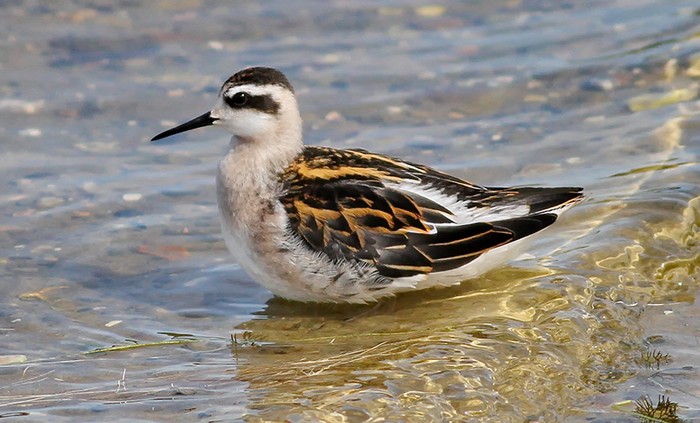
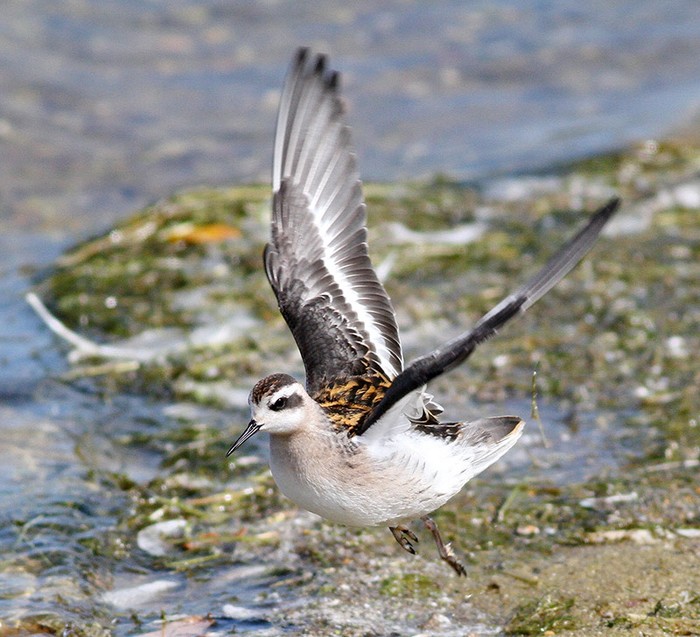
The juvenile White-winged Black Terns found last week at Dungeness (Kent) remained there still as the week began on 2nd, with one bird remaining until 8th, latterly hanging out over the productive waters of the famous ‘patch’. Further single juveniles were noted feeding offshore at Hove (East Sussex) on 2nd; and in Norfolk at Ormesby Broad on 5th-8th.
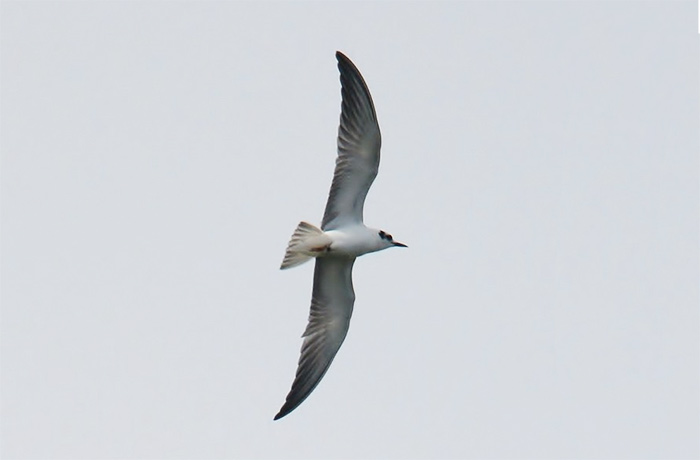
In Ireland the adult Forster’s Tern was on the Rogerstown Estuary (Co.Dublin) on 6th-7th. It’s been said before, but bears repeating – away from Ireland this is an exceedingly hard species to come by these days. We go back to 2003 for the last non-Irish record, one up in Argyll on 8th-11th January. Another one in Cornwall this coming autumn would be deservedly popular.
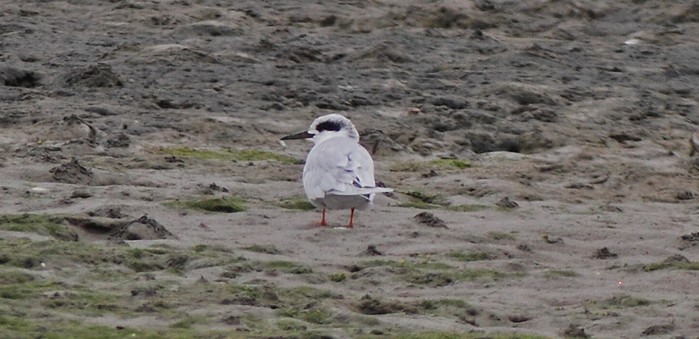
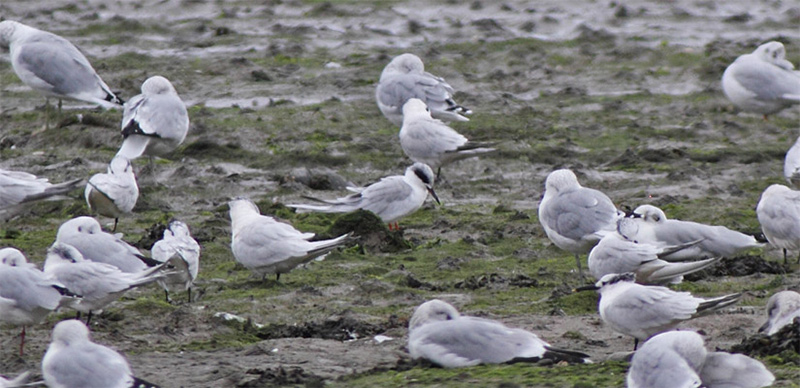
Very peaceful indeed in the Wonderful World of Gulls this week – the half dozen Yorkshire Sabine’s Gulls recorded being pretty much the pick of a slim crop. Adults passed Long Nab (North Yorkshire) on 4th and 6th; on 5th, two passed Spurn YWT (East Yorkshire) in the morning with a further one noted in the afternoon; and on 6th one was logged off Hornsea (East Yorkshire).
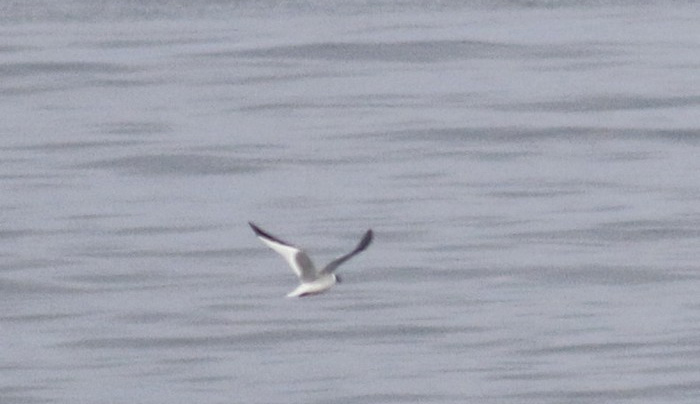
Slim pickings of Ring-billed Gulls were to be had – the second-winter individual remained at Preston Dock (Lancashire) until 6th; while from Ireland reports came from Blackrock (Co.Louth) on 3rd, Lough Foyle at Myroe (Co.Derry) on 7th, and Black Rock Strand (Co.Kerry) on 8th.
Only slightly more white-wingers to report in the past few days – starting with three Glaucous Gulls, two of them in Ireland - one on Tory Island (Co.Donegal) on 5th and the other at Courtown (Co.Wexford) on 7th – and one in Scotland on the Lossie Estuary (Moray) on 8th. The Orkney mainland accounted for half the week’s crop of Iceland Gulls with a second-summer at Bay of Skaill on 2nd and an adult at Marwick on 7th; elsewhere, on 6th single birds were noted on Fair Isle (Shetland) and in Ireland at Lough Swilly (Co.Donegal).
This week’s raptor news begins with a conclusion - it looks like the settled and thoroughly gorgeous first-summer male Red-footed Falcon has now departed Willow Tree Fen LWT (Lincolnshire), being last seen there on 2nd. An adult female kicked the week off in Somerset, being seen at Steart WWT on 2nd. A further unconfirmed report of an immature male came from Titchwell RSPB (Norfolk) on 6th.
A Black Kite was reported from Radyr (Glamorgan) on 5th-6th. Another report of the species in Glamorgan came in late on 8th with news of a probable over Tonyrefail.
A juvenile Montagu’s Harrier was noted in Kent in the Capel Fleet area of Sheppey on 4th-5th in an otherwise quiet week for the species.
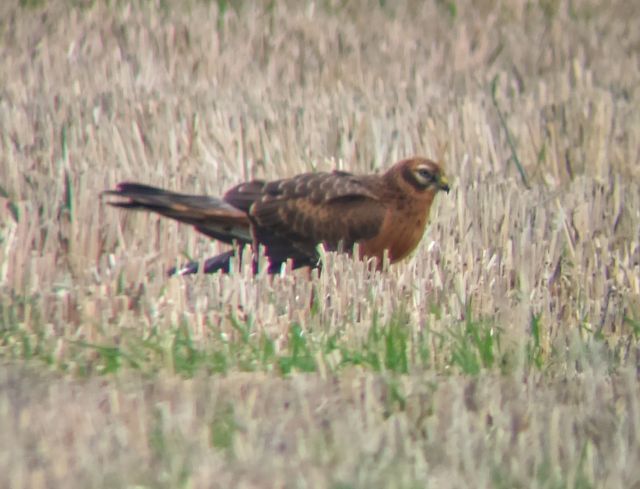
Also calming down after last week’s strong showing were Honey Buzzards - down to some 24 individuals noted from last week’s high of 38 with many of them, predictably enough, at coastal locations.
In chronological order then, the week started with birds seen on 2nd at Chambers Wall and Sandwich Bay (Kent), Beachy Head (East Sussex), Wyke Regis (Dorset); and in East Anglia at Breydon Water RSPB (Norfolk) and Hollesley Marshes RSPB (Suffolk). On 3rd individuals were noted at Capel St.Mary (Suffolk), Painswick Beacon (Gloucestershire), Stapleford (Nottinghamshire) and Dungeness (Kent). The latter site accounted for another sighting on 4th, with further birds noted that day in West Sussex at Angmering and Selsey Bill.

There was a midweek lull on 5th with one bird logged in Surrey at Woldringham before the pace picked up again on 6th – with individuals noted in Nottinghamshire at Mansfield Woodhouse and Market Warsop, over Blithfield Reservoir (Staffordshire), at Beckton (London), Whitburn (Co.Durham), and reported from Stow Marsh (Essex). London and Nottinghamshire featured again on 7th with individuals seen over Beddington SF and Carlton respectively. The week closed with birds noted over Beachy Head (East Sussex) and Eastbridge (Suffolk).
Compared with the week that preceded this, the week we’re currently looking back upon was on the whole fairly peaceful. But there were rumblings throughout that hinted at what might have been (had the weather been kinder) and what might be to come – particularly on 8th when, amongst other things, the first Yellow-browed Warblers of the autumn made landfall, with one at Langham in Norfolk in the morning just pipping one on Papa Westray (Orkney) to the post, closely followed by one at Wester Quarff on the Shetland mainland as the day went by.
And what’s that sound I hear? Yes, I think it’s the sound of some migration floodgates opening again in the coming days. But before we all head out into the field to get us some hot warbler action, let’s recap what the last week had to offer...
While Icterine Warblers were conspicuous by their absence this week – on Fair Isle still on 2nd-4th, and at Kilnsea (East Yorkshire) on 5th – there were a handful of tasty other warbler species to be had.
The ringers’ nets were once again productive at Nanjizal (Cornwall) on 2nd, with a Blyth’s Reed Warbler trapped and ringed there; while a similarly satisfactory result was obtained on North Ronaldsay (Orkney) where a Greenish Warbler was present, and trapped and ringed, on 3rd-6th.
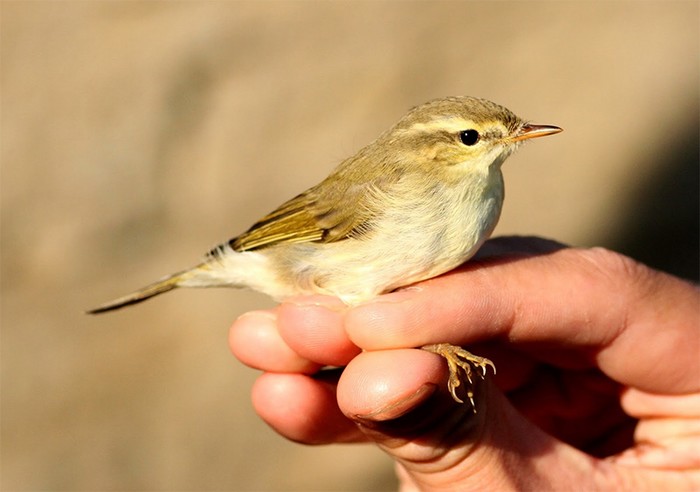
Nearby Fair Isle (Shetland) attracted an Arctic Warbler on 8th.
Back in the southwest, another autumnal Paddyfield Warbler was seen briefly on Scilly’s St.Agnes – but wasn’t relocated latterly.
Flitting up and down the country in typically hyperactive warbler stylee, we come to the probable Subalpine Warbler sp. seen on Lewis (Western Isles) on 4th-5th. As I think any of us who’ve tried to come to grips with a skulking Sylvia would attest, they can be fiends to dig out when they’re not cooperative – and this particular individual was to provide a further object lesson in the perils inherent in assessing digital photos. Modern technology – mostly, but not entirely, the friend of birders... Another elusive Subalpine Warbler sp. heralded the week’s end on 8th, appearing briefly at Kelling (Norfolk).
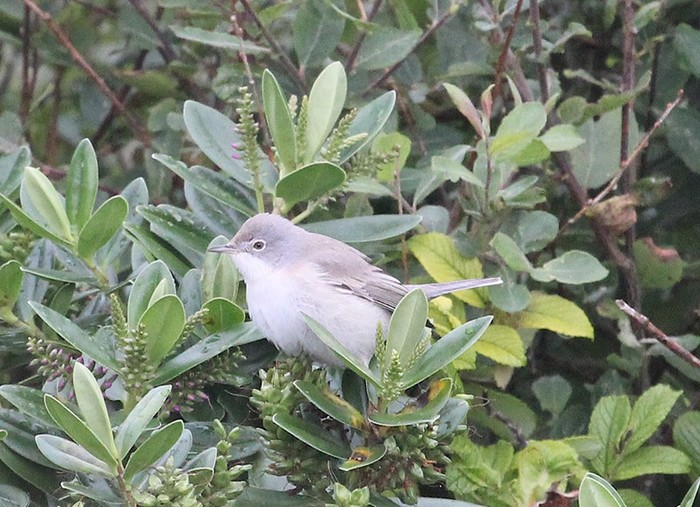
We come to the tail end of the week’s rarer warblers in the bosky surroundings of Shite Lane on Galley Head (Co.Cork) – where, despite the unpreposessing name, a lovely Western Bonelli’s Warbler was to be had frisking through the sycamores and pines on the 8th.
A Marsh Warbler was reported from Climping (West Sussex) on 3rd.
Finishing the warblers off are this week’s Barred Warbler offerings – fairly modest offerings they were at that. Brace yourselves though in the coming days... This week however a number of birds settled down for a few days refuelling their fat reserves – individuals were noted on St.Agnes (Scilly) on 2nd-3rd; Warham Greens (Norfolk) on 2nd-7th; Portland (Dorset) on 3rd-5th; Kilnsea (East Yorkshire) on 4th-8th; Balephuil on Tiree (Argyll) on 6th-7th; and in a gift for inland birders, at Staines Moor (Surrey) on 2nd-8th. Other birds were logged on 2nd at Caister-on-Sea and Wells Woods (Norfolk), Gibraltar Point (Lincolnshire), Fair Isle (Shetland), Spurn YWT (East Yorkshire) and Burravoe on Yell (Shetland); on 4th at Hartlepool Headland (Cleveland) and Beckton (London); on 5th at Southwold (Suffolk); on 6th at St.Margaret’s Bay (Kent), trapped and ringed at Gibraltar Point (Lincolnshire), and on North Ronaldsay (Orkney) – with two there the following day; and on 8th one was trapped and ringed at Titchfield Haven NNR (Hampshire).
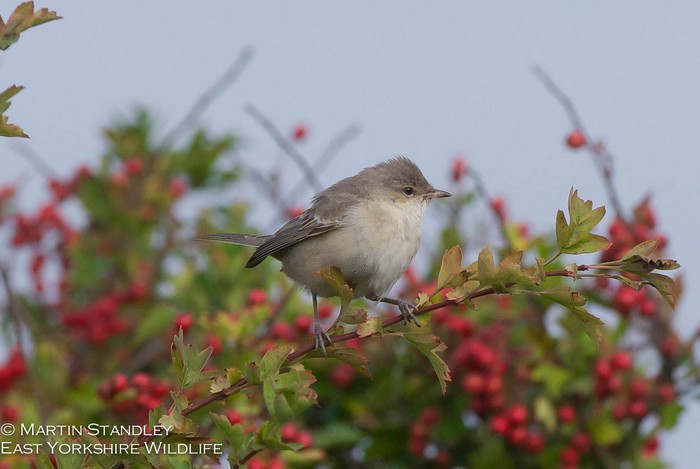
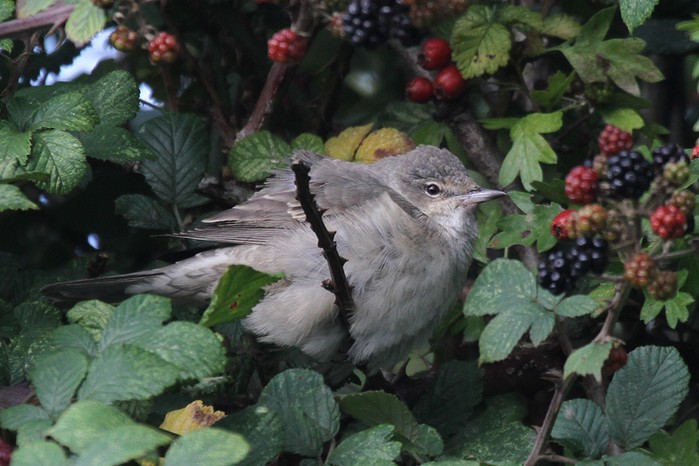
More traditional autumn migratory fare came our way in the form of scattering of Red-backed Shrikes - all singletons with the exception of two at Burravoe on Yell (Shetland) on 2nd. Elsewhere in the archipelago one was on Mainland at Boddam on 5th, a further bird was on Unst at Westing on 6th, and one was again at Burravoe on Yell on 8th.
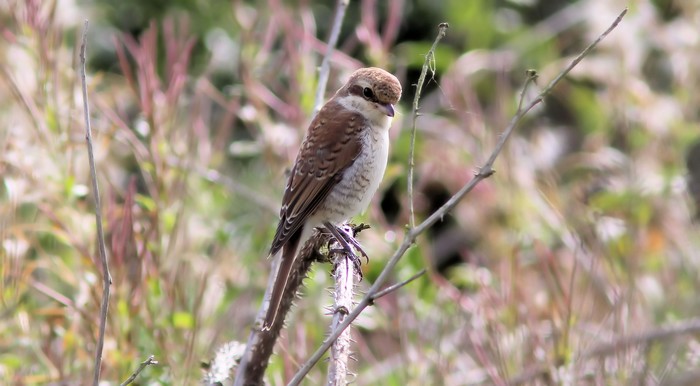
Hangers-on from last week remained at Cleethorpes (Lincolnshire) and The Hythe (Essex) on 2nd, at Minsmere RSPB (Suffolk) until 4th and at Kilnsea (East Yorkshire) until 8th, when it was trapped and ringed. Further birds came out of the woodwork at Dungeness RSPB (Kent) on 2nd-7th; on Beachy Head on 2nd-3rd and at Rye Harbour (East Sussex) on 3rd; on the 4th at Durdle Door (Dorset), The Lizard (Cornwall) and Meols (Cheshire) – the latter bird there still on 5th; on 5th-7th at Stone Creek (East Yorkshire); on 6th at Spurn YWT (East Yorkshire) and Wells-next-the-Sea (Norfolk), and on 6th-7th at Otmoor RSPB (Oxfordshire) and St.David’s Airfield (Pembrokeshire); a possible report came from Yateley Common (Hampshire) on 7th; and on 8th a new individual was at Spurn, with further birds that day at Salthouse and Waxham (Norfolk).
Still plenty of Wrynecks to report this week, though not I think quite enough to warrant a section all of their own..
Having said that, the London representatives definitely deserve a paragraph to themselves – a superb bird to see anywhere, let alone in the big smoke, so a tremendous find for the patchworkers involved. Birds were still at Wanstead and Alexandra Flats on 2nd, the latter individual still there on 3rd; and at Crayford Marshes on 2nd-3rd.
Kent accounted for seven records this week – at Dungeness on 2nd; Pegwell Bay on 2nd-3rd; Leysdown-on-Sea and Margate on 4th; Conyer Creek and St.Margaret’s Bay on 6th; and at Dartford Marshes on 7th.
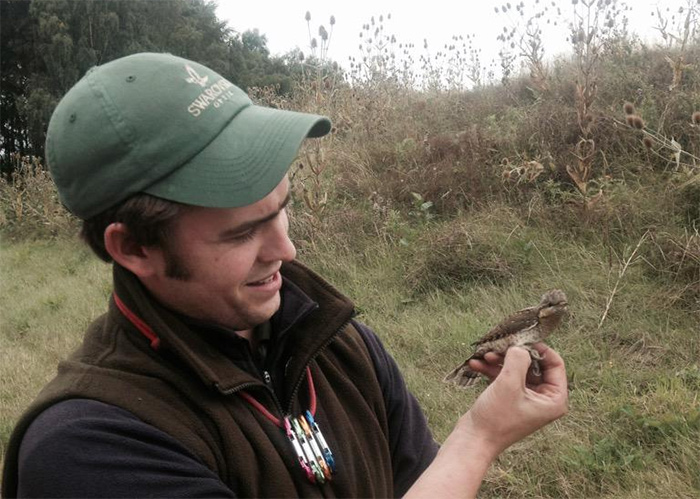
Elsewhere there were a scatter of records from, almost exclusively, eastern and southern coastal counties. On 2nd birds remained at Nanjizal (Cornwall), Seaford (East Sussex), at Hook-with-Warsash LNR (Hampshire) until 5th, and at Portland (Dorset) until 7th. Further new birds were found that day at Dorman’s Pool (Cleveland), Farlington Marshes HWT (Hampshire), Frampton Marsh RSPB (Lincolnshire), Wavering Down (Somerset), on 2nd-4th on St.Agnes (Scilly), and on 2nd-5th at Norton Green (Hertfordshire).
Handfuls of new birds were recorded daily thereafter. On 3rd individuals were reported from Winsford (Cheshire), Hastings CP (East Sussex), Chepstow (Gwent) and Leith Hill (Surrey). On 4th birds were logged at Charmouth and Hengistbury Head (Dorset), Port Meadow (Oxfordshire) and Spurn (East Yorkshire); on 5th from Skewjack (Cornwall); on 6th at Salisbury (Wiltshire) and on St.Mary’s (Scilly); on 7th in Dorset at Osmington Mills and Durlston CP, at Scammonden (West Yorkshire) and two birds in Nanquidno Valley (Cornwall). One seen at Farlington Marshes (Hampshire) on 8th was presumably the bird from earlier in the week; one was trapped and ringed that day in Leicestershire at Rutland Water.
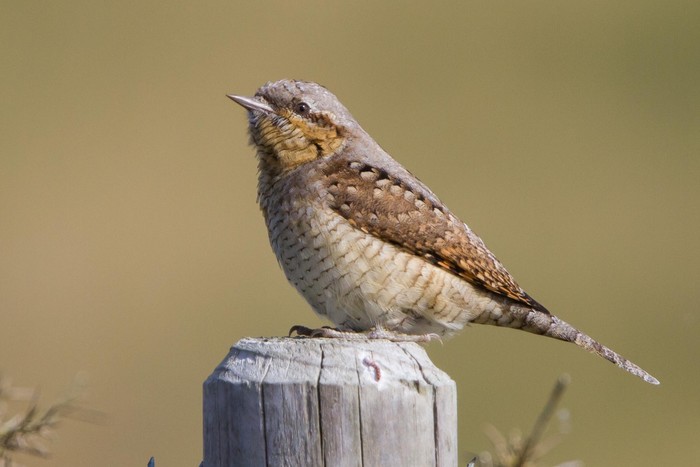
Onto more colourful fare, we head back to the summer’s hot breeding story, the Bee-eaters at Lower Gelt Quarry in Cumbria. With the adults still present at the start of the week, two youngsters finally emerged on 4th. With no sign of any birds at all on 6th, access to the site was finally ceased at the conclusion of this successful breeding attempt; though the adults and one of the juveniles was seen nearby on 7th-8th in the vicinity of the local beehives... The beekeeper in question must be wondering what he did in a former life to deserve a technicolour reward like that.
Hoopoes from last week remained at Carnyorth Common (Cornwall) until 5th and Sandwich Bay (Kent) until 3rd. New birds turned up at Norwick on Unst (Shetland) on 4th, Portland (Dorset) on 7th and New Brighton (Cheshire) on 8th.
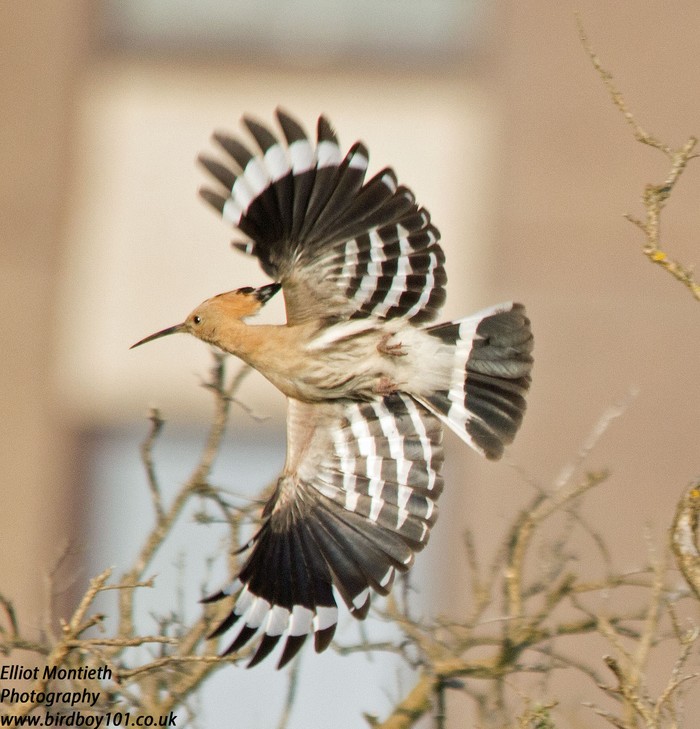
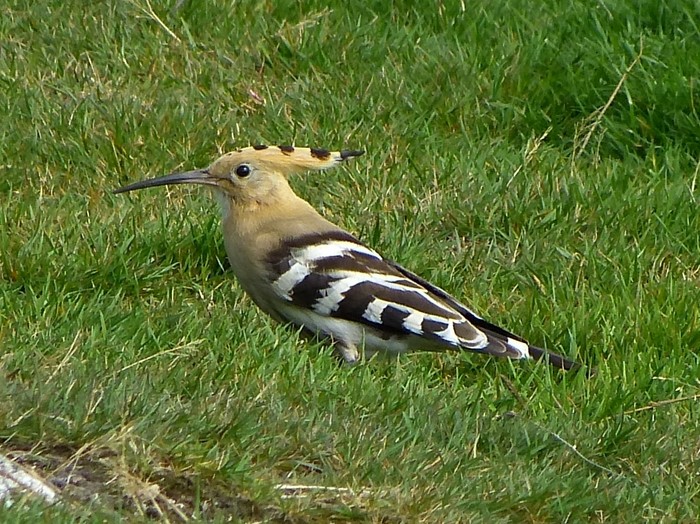
The adult Rose-coloured Starlings were again reported from Stornoway on Lewis (Western Isles) on 6th and Kilchoman on Islay (Argyll) on 7th. Less colourful juveniles were present in some numbers further south: two were at the campsite on Bryher (Scilly) on 6th; and one was again at St.Levan on the Cornish mainland on 7th – with three there on 8th, and one seen at Porthgwarra that morning also.
Just the one Bluethroat to report this week, up on Orkney’s Papa Westray on 6th.
Two Citrine Wagtails were found, both in the anticipated northern quarters of Orkney and Shetland. The first remained on Fair Isle from 2nd-8th while a little way south on North Ronaldsay one was present on 6th-8th.
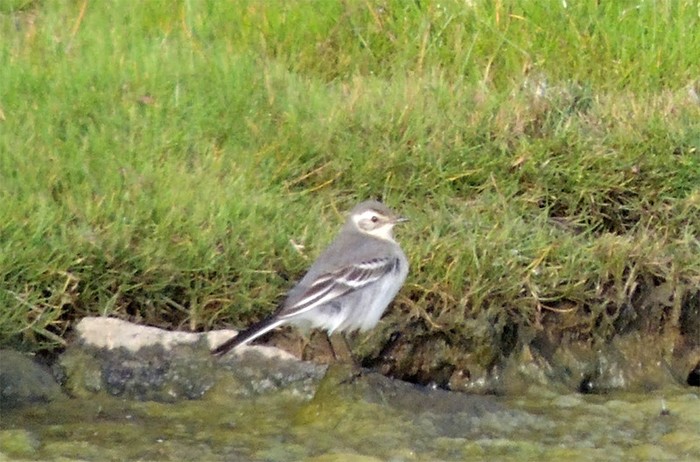
Back on the south coast a Tawny Pipit was on Hayling Island (Hampshire) on 5th.
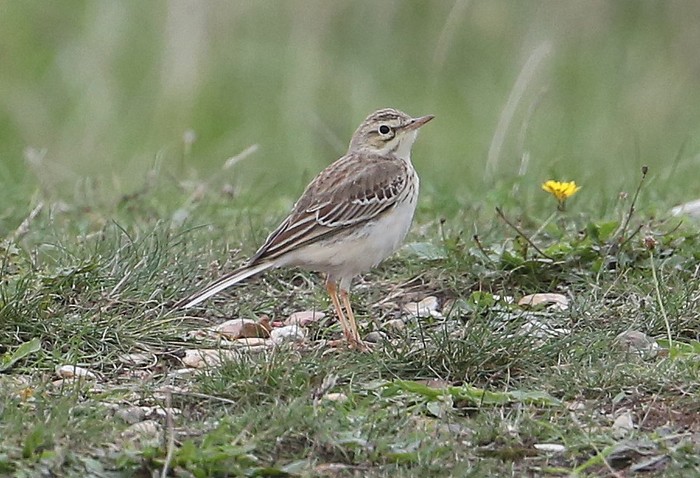
Three Common Rosefinches this week are surely just the vanguard of many more to come in the weeks ahead of us – one remained on Fair Isle (Shetland) until 3rd, one was on North Ronaldsay (Orkney) on 3rd-6th, and one was on the Isle of May (Fife) on 8th.
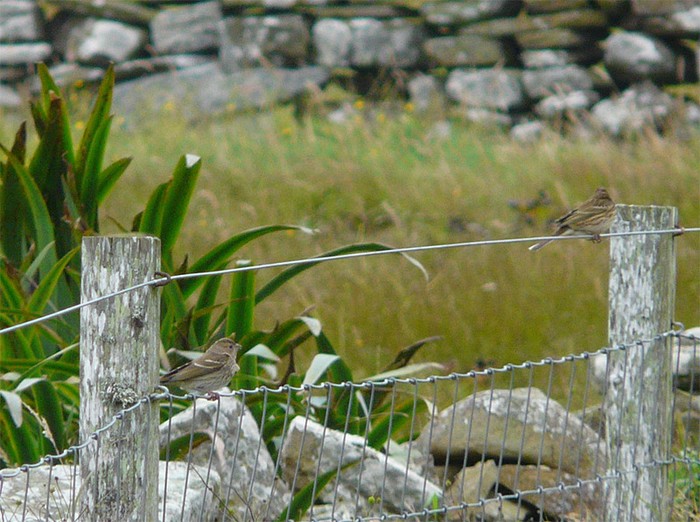
And this week’s witterings come to their natural conclusion with a couple of the always charming Ortolan Buntings -one flew over Portland (Dorset) on 4th, while one was in the hidden fastness of Nanjizal Valley (Cornwall) on 5th-7th.
We’re really moving into prime time for something special on the rarity front now, unhelpful wind directions notwithstanding. We’re standing in that wonderful no-man’s-land where almost anything seems feasible.
On the one hand, we’re still charting waters where, statistically speaking, we stand a good chance of bumping into a decent seabird. Anybody despairing of a good airflow off the Urals might want to spend some hours propping up a Cornish or Irish headland instead and adding to the early autumn’s tally of Fea’s Petrel or Barolo Shearwater.
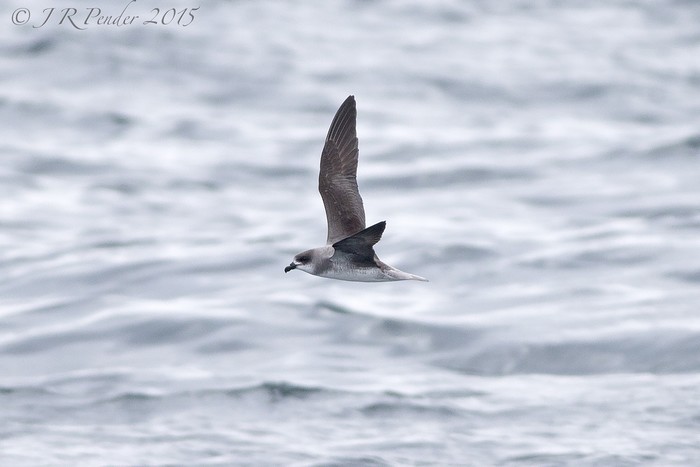
On the other hand, it’s hard to resist the chance to scope a tasty shorebird or two. The coming week has plenty of form on that front, with all manner of wader loveliness a possibility.
(I could reference the Hudsonian Godwit that graced Blacktoft Sands on 10th September 1981 but, y’know, seems a bit passé for some reason this year...)
Pretty much every American wader on the British list appears to have made an appearance during the coming week at some point in the past, so almost anything’s in with a shout it seems. Maybe a peep is on the cards – most likely a Semi-p, but both Least and Western Sandpipers have been found this week in the past decade.
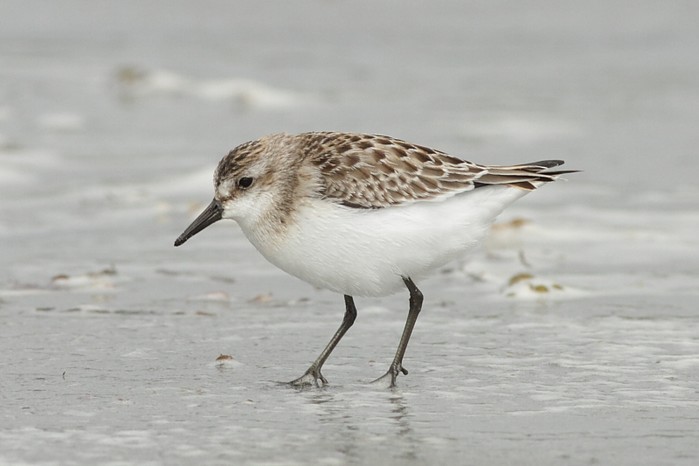
But who am I kidding? It’s something eastern we all crave as we head into mid September. While a Thick-billed Warbler (Out Skerries, Shetland, 14th September 2001) or Eastern Olivaceous Warbler (Shetland again, at Bigton on 11th-12th September 2010) comes along once in a blue moon, the likes of Greenish, Arctic and, to a somewhat lesser extent, Booted Warblers are much more regular, and have a solid precedent of turning up in the coming week all down the east coast. (But, to be fair, with the lion’s share still in Shetland!)
It doesn’t have to be a passerine either. Who can forget the steep, anguished learning curve of the Amur Falcon found at Tophill Low (East Yorkshire) on 14th September 2008, present there until mid October? We all know what to look for in any autumn Red-footed Falcons nowadays...
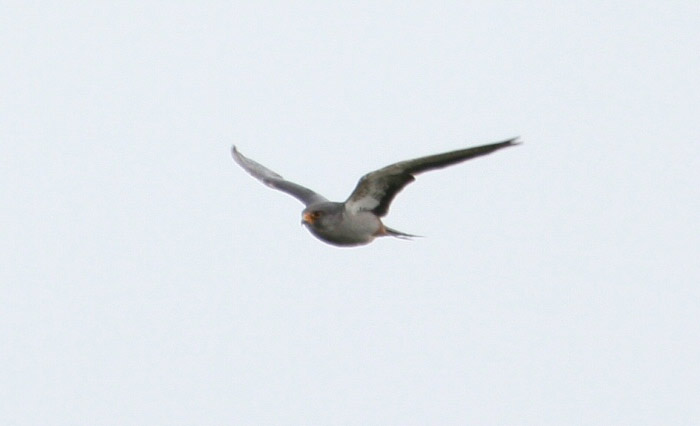
Yes, almost anything’s possible at this time of year. Every day feels like Christmas morning as a kid. You just don’t know what to expect.
It might be the birding equivalent of the Leatherette Craft set. (Anyone? No? Just me?) Or it could be something really special, a bird as momentous as unwrapping a Dukla Prague away kit for your Subbuteo: this week’s produced Hooded Warbler on 10th September 1992, and Blackburnian Warbler on 12th-14th September 2009. Granted both were on St Kilda, but a boy can dream...
Jon Dun
09 Sep 2015
Please note: we put a lot of time and effort into sourcing and and producing the images, videos and graphics for each roundup. Some of you (probably Apple users) may notice some photos etc. that appear to have incorrect captions. Please try refreshing the page as they are correcty captioned. If after a refresh they are still showing the incorrect captions then please email us
















